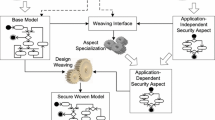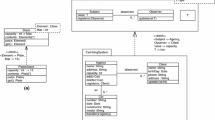
Overview
- Uniquely combines model-driven engineering with the aspect-oriented paradigm to develop secure software systems
- Reconciles academic rigor and preciseness with industrial applicability and relevance
- Based on a fruitful close cooperation between academia and industry
- Includes supplementary material: sn.pub/extras
Access this book
Tax calculation will be finalised at checkout
Other ways to access
About this book
This book comprehensively presents a novel approach to the systematic security hardening of software design models expressed in the standard UML language. It combines model-driven engineering and the aspect-oriented paradigm to integrate security practices into the early phases of the software development process. To this end, a UML profile has been developed for the specification of security hardening aspects on UML diagrams. In addition, a weaving framework, with the underlying theoretical foundations, has been designed for the systematic injection of security aspects into UML models.
The work is organized as follows: chapter 1 presents an introduction to software security, model-driven engineering, UML and aspect-oriented technologies. Chapters 2 and 3 provide an overview of UML language and the main concepts of aspect-oriented modeling (AOM) respectively. Chapter 4 explores the area of model-driven architecture with a focus on model transformations. The main approaches that are adopted in the literature for security specification and hardening are presented in chapter 5. After these more general presentations, chapter 6 introduces the AOM profile for security aspects specification. Afterwards, chapter 7 details the design and the implementation of the security weaving framework, including several real-life case studies to illustrate its applicability. Chapter 8 elaborates an operational semantics for the matching/weaving processes in activity diagrams, while chapters 9 and 10 present a denotational semantics for aspect matching and weaving in executable models following a continuation-passing style. Finally, a summary and evaluation of the work presented are provided in chapter 11.
The book will benefit researchers in academia and industry as well as students interested in learning about recent research advances in the field of software security engineering.Similar content being viewed by others
Keywords
Table of contents (11 chapters)
-
Front Matter
-
Back Matter
Authors and Affiliations
About the authors
The authors of this book conducted several research initiatives in the area of computer security, privacy and cyber forensics. The content reported is the result of a 4-year research project on the aspect oriented security hardening of UML design models and is based on a fruitful collaboration between Concordia University and Ericsson under a research partnership program of the Canadian Natural Sciences and Engineering Research Council (NSERC).
Bibliographic Information
Book Title: Aspect-Oriented Security Hardening of UML Design Models
Authors: Djedjiga Mouheb, Mourad Debbabi, Makan Pourzandi, Lingyu Wang, Mariam Nouh, Raha Ziarati, Dima Alhadidi, Chamseddine Talhi, … Vitor Lima
DOI: https://doi.org/10.1007/978-3-319-16106-8
Publisher: Springer Cham
eBook Packages: Computer Science, Computer Science (R0)
Copyright Information: Springer International Publishing Switzerland 2015
Hardcover ISBN: 978-3-319-16105-1Published: 22 April 2015
Softcover ISBN: 978-3-319-36894-8Published: 08 October 2016
eBook ISBN: 978-3-319-16106-8Published: 22 April 2015
Edition Number: 1
Number of Pages: XVIII, 237
Number of Illustrations: 123 b/w illustrations



